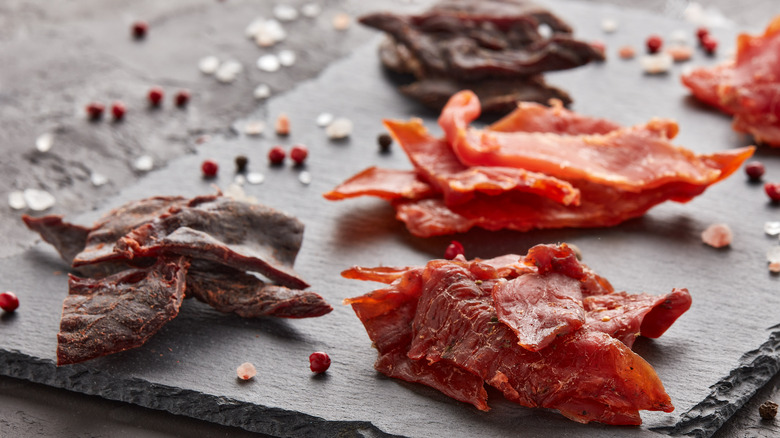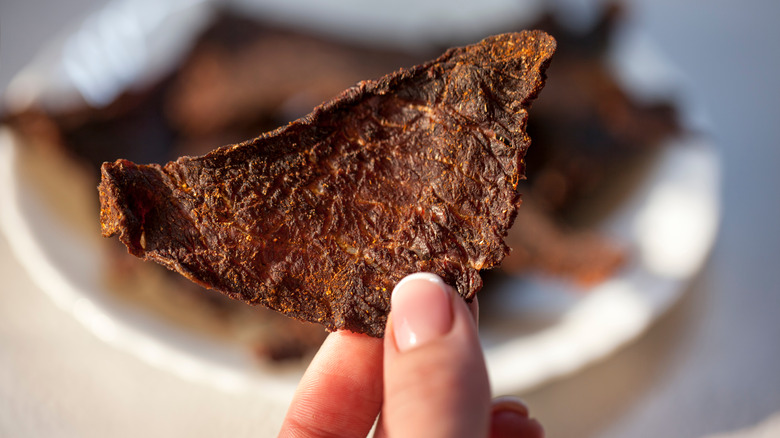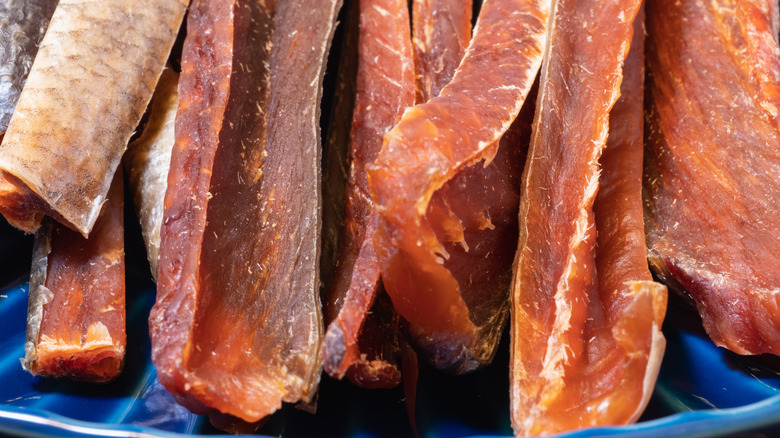The Best Cuts Of Meat For Jerky
If you are looking for evidence that humans, from culture to culture and throughout time, are more alike than they are different, food is a good place to start your search. Though ingredients vary, our need to store and transport food has been a near-constant, and themes appear when you examine the techniques we've devised around the planet to accomplish this. Some of the most prized and iconic foodstuffs, from kimchi, to caviar, to country ham, are the blissful result of our use of salting, drying, and aging to extend their life span. Another item, famous to campers, cowboys, and folks on long road trips, is that ambrosia of gas stations from coast-to-coast: jerky.
According to Taste Atlas, the word jerky comes to us from the Quechua language of the Inca. Charqui means "dried" and "thin" and refers to pieces of meat that have been preserved with salt and dried in the sun and high-altitude Andean air. In the expanse of time before refrigeration, aka most of recorded history, processes like these were crucial to preserving meat.
Jerky by any other name
Before the arrival of Europeans in the Americas, Inca charqui, or ch'arki, referred to the treatment of meat from domesticated llamas and alpacas, explains Thought Co. But with conquistadors came the livestock they were familiar with, introducing cattle to the "new world" (via Live Science.) Fast forward to the present and beef is the most prevalent type of meat used for jerky, according to Allied Marketing Research.
The method of preparation for beef jerky has changed little over the centuries. Take, for example, Alton Brown's recipe, which calls for heavily salting and seasoning the beef, albeit with soy and Worcestershire sauces for an added umami boost, before drying the meat for 8-12 hours using an inventive DIY dehydrator fashioned from HVAC air filters and a common box fan.
As Food Fire Friends points out, choosing a piece of meat for jerky runs counter to the way we choose most other cuts of meat. Rather than reaching for a cut marbled with flavorful fat, jerky cuts need to be as lean as possible. This aids with preservation — fat can turn rancid — and renders a nicely dry and chewy final product.
They recommend cuts from the round, a primal consisting of a good portion of the hind leg and rump of a cow (via The Spruce Eats.) This well-worked area yields cuts such as the eye of round, top round, and outside round, all worthy cuts for jerky.
Beyond beef
While beef may reign supreme when it comes to jerky, there are quite a few alternatives for carnivores, vegetarians, and vegans alike that make a delightful snack.
Those looking to add more fish to their diet might try salmon jerky, with this recipe from Hunter Angler Gardener Cook being a prime example. Rich in omega-3 fatty acids, salmon's bold flavor proves an able foil for sweet and salty combinations, such as teriyaki.
For hunters, jerky is a great option to preserve lean game meats. Recipes range from venison – Meat Eater has a great option for horned and antlered game — to duck — this Traeger Grills guide works for goose as well — to wild boar — paired with orange in this Bush Cooking entry.
In the non-meat category, options abound as well. Integris Health has a round-up of recipes appealing to all sorts of tastes, including air fryer mushroom jerky, smoky cauliflower jerky, and eggplant jerky. Also provided is a list of helpful tips should you want to freestyle with your favorite veggie.
The moral of the story is, whether you're aiming to make a meaty snack or a vegetarian jerky, look for cuts of meat and vegetables that are low in fat with enough integrity to withstand the curing and drying process. Bold flavors, such as those found in beef, game, and certain fish, can hold their own against assertive marinades, but milder choices of meat and vegetables have their place as they allow other elements to shine.


